The Evolution of Wireless Connectivity: LiFi’s Game-Changing Potential
Wi-Fi, leveraging radio waves for data transmission, has profoundly impacted our digital age. Notable studies, such as the one conducted by Direct Line through Opinium Research, emphasize the significance of Wi-Fi in our daily lives. Yet, despite its pervasive presence, challenges like inconsistent internet connectivity persist.
Emerging from this backdrop is LiFi, a transformative alternative poised to reshape our wireless communication experiences. By harnessing the vast bandwidth of the light spectrum, LiFi promises speeds that can eclipse conventional Wi-Fi by up to 100 times. But it’s not just about speed. With LiFi, connecting to the internet could be as straightforward as turning on a light. Utilizing LED-based light to convey data, this technological shift guarantees rapid data transfer, while also excelling in environments where electromagnetic interference is a concern, such as hospitals or airplanes.
Decoding the Mechanics of LiFi
At its essence, LiFi operates as a Visible Light Communications (VLC) system, promising unparalleled wireless internet speeds. Central to this system are LED light bulbs. These bulbs emit swift light pulses, imperceptible to the human eye, laden with information. It’s akin to an advanced, hyper-speed Morse code. Devices fitted with the requisite receivers decode this influx of data at breathtaking speeds. Demonstrated potential transmission rates for LiFi have even surpassed 224 Gbps, a pace that dwarfs WiGig, one of the most rapid Wi-Fi technologies.

Get Your Free LiFi eBook Now
Discover the cutting-edge world of LiFi with our invaluable eBook, normally priced at $27, now available for free for a limited time! Join over 2650 pioneers who've already downloaded this essential guide to the next wave in wireless technology. Packed with insights and practical applications, this ebook is your key to understanding and utilizing the revolutionary LiFi. Act fast—this exclusive offer won't last. Download your free copy today and step into the future of connectivity!
LiFi’s Inherent Security Edge
The modus operandi of LiFi, using light for data transfer, furnishes it with intrinsic security advantages. A standout feature is the confinement of light-bound data within its immediate environment, courtesy of light’s inability to traverse walls. This characteristic ensures that data interception by unauthorized entities outside the designated space becomes a near impossibility, adding a robust layer of security to wireless communication.
The Promise of LiFi
When compared with traditional radio wave-driven technologies, LiFi’s distinctiveness is hard to ignore. It heralds a future of wireless communication marked by astounding transmission speeds, heightened security, and the potential to radically transform our digital interactions. As the world gravitates towards more interconnected devices and fluid communication, LiFi emerges as the vanguard technology poised to redefine our digital horizons.
Understanding LiFi’s Technical Foundations
LiFi’s underpinning is both innovative and straightforward. The technology relies on a modulated light frequency emitted by LED light sources. When data needs to be transmitted, the LED’s brightness oscillates at ultra-high speeds, too rapid for the human eye to perceive. These oscillations or ‘flickers’ represent binary codes of 1s and 0s—essentially the language of computers. On the receiving end, a photosensitive detector captures these light signals. The detector then demodulates the light fluctuations back into electronic data. Given the sheer speed of these oscillations, vast amounts of data can be transferred in a fraction of a second. Accompanying an explainer image, this should provide a clearer visual representation of how LiFi’s intricate dance of light translates into digital communication.

WiFi (Wireless Fidelity) vs. LiFi (Light Fidelity)
Advantages
LiFi: Less interference, can pass through salty sea water, works in dense region
Application
LiFi: Used in airlines, undersea explorations, operation theaters in the hospitals, office and home premises for data transfer and internet browsing
Coverage distance
LiFi: About 10 meters
Data density
Interference
Operation
Privacy
Looking at the data above, the biggest disadvantage of LiFi technology is its coverage distance. Since light can’t pass through walls, the signal’s range is limited by physical barriers.
LiFi is probably not the replacement of WiFi technology anytime soon. Instead, it is an incredible companion for it. By positioning LiFi as a complementary technology to WiFi, this promising technology will take wireless connectivity to new heights.
Stay Updated On All Things LiFi
Subscribe to our FREE newsletter
Participate in LiFi product giveaways
Get LiFi news updates
What does LiFi mean for everyone?
LiFi technology is poised to revolutionize wireless communication, providing faster and more secure data transfer than traditional WiFi. Although it functions similarly to WiFi, using light instead of radio waves to transmit data, LiFi boasts vastly greater bandwidth capacity, making it ideal for use in densely populated urban areas. In fact, street lamps could soon be used to provide data to everything from pedestrians to vehicles, improving the functionality of city infrastructure. While currently mainly used in industrial settings, LiFi is predicted to make its way into smart homes and become an integral part of future building automation. With its speed and security advantages, LiFi is set to be a game changer in the world of wireless communication.
Why is LiFi important?
Consumption of wireless data increases by 60% every year. That means that the radio-frequency space is slowly becoming saturated which can lead to a phenomenon called a spectrum crunch. Spectrum crunch refers to the potential lack of sufficient wireless frequency spectrum needed to support a growing number of consumer devices, along with various government and private sector uses of radio frequencies within a broad spectrum allocated for different types of wireless communications. This poses challenges with wireless networks because it would negatively affect the speed of our internet usage.
Eventually, WiFi will not be able to keep up with the demand for data.

Get Your Free LiFi eBook Now
Discover the cutting-edge world of LiFi with our invaluable eBook, normally priced at $27, now available for free for a limited time! Join over 2650 pioneers who've already downloaded this essential guide to the next wave in wireless technology. Packed with insights and practical applications, this ebook is your key to understanding and utilizing the revolutionary LiFi. Act fast—this exclusive offer won't last. Download your free copy today and step into the future of connectivity!
A Brief History of LiFi
LiFi technology, which stands for light fidelity, was introduced by Professor Harald Haas in his 2011 TED Global talk. Haas, who is the Chair of Mobile Communications at the University of Edinburgh, co-founded pureLiFi, a company that produces LiFi products for integration with LED-lighting systems.
In 2013, pureLiFi released the world’s first commercially available LiFi technology, the Li-1st. This marked a groundbreaking milestone in wireless communication technology. Two years later, pureLiFi partnered with French lighting company Lucibel to launch the world’s first industrialized LiFi solution, which has been deployed in multiple locations, including Microsoft’s Paris headquarters.
The LiFi-XC system, released in 2017, is a certified plug-and-play system that works with USB devices and can be integrated into laptops, tablets, and smart appliances. In June 2018, pureLiFi offered LiFi starter kits to academic researchers and launched a channel program for IT resellers to add LiFi to their portfolio.
LiFi technology provides numerous benefits, including faster internet speed and increased security, particularly in areas where radio frequencies may be unsafe or unavailable. With its rapid growth and expansion, LiFi technology is sure to revolutionize wireless communication in the years to come.
The history of LiFi has been marked by various milestones since Professor Haas introduced the technology in 2011. Since then, pureLiFi has been at the forefront of developing and commercializing LiFi products. Many other companies have also started working on LiFi products and solutions, and the market is growing rapidly. The global Li-Fi market is projected to reach $4.5 billion by 2035, with a compound annual growth rate of approximately 65%, according to a Research Nester report.
Download Our White Paper
Learn what LiFi is and how it works
Discover how LiFi will change our lives
View future predictions for LiFi
Read about commercial opportunities
LiFi sustainability
LiFi technology is not only fast, but it is also environmentally sustainable. One of the main advantages of LiFi technology is that it eliminates the need for electronic devices such as routers, modems, signal repeaters, wave amplifiers, and antennas, which consume energy 24/7. Since LiFi is connected to LED bulbs, it does not require additional power consumption, thus reducing costs in homes and workplaces.
Furthermore, LiFi technology has the potential to use solar energy to transmit data, making it possible for people without internet access or with limited electricity resources to connect wirelessly to the web. With LiFi, there is a great opportunity to bring internet access to remote and underdeveloped regions, which can help bridge the digital divide.
As more and more companies are working on LiFi products, and many LiFi products and solutions have been created since, the global Li-Fi market is growing fast.

Get Your Free LiFi eBook Now
Discover the cutting-edge world of LiFi with our invaluable eBook, normally priced at $27, now available for free for a limited time! Join over 2650 pioneers who've already downloaded this essential guide to the next wave in wireless technology. Packed with insights and practical applications, this ebook is your key to understanding and utilizing the revolutionary LiFi. Act fast—this exclusive offer won't last. Download your free copy today and step into the future of connectivity!
How close are we to using LiFi?
LiFi technology has been in development for over a decade, and many LiFi products have been created since its inception. Companies across various industries such as defense, healthcare, lighting, IT infrastructure, telcos, and device integrators are working on LiFi solutions for various use cases.
More and more companies are realizing the potential of LiFi and investing resources in research and product development. While it is not yet widely available to the general public, the technology is steadily advancing, and it is only a matter of time before it becomes more prevalent in our daily lives.
The future of LiFi
Right now, LiFi cannot fully replace WiFi as a connectivity source, however, there are several LiFi companies that are working hard on developing LiFi products and marketing LiFi as the primary wireless technology. The demand for fast internet access is increasing every day and light fidelity could be the technology to meet this demand.
Many LiFi products have been created and are in development, and more companies are utilizing LiFi solutions for various use cases. The future of the internet looks bright with the potential of LiFi technology.
Transform Your Internet Experience
Join the LiFi revolution, where unparalleled speed meets unprecedented security.